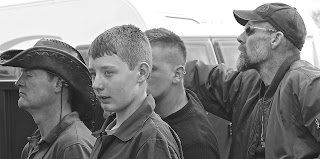Exercise: A narrative picture essay
This evening we were visited by the Italian couple whom I intend interviewing and photographing for this exercise. Over a tea of home made pizza, pizzette, roast peppers and Italian bread, we spoke of how the exercise might be carried out.
To help show what might emerge I showed Alessandra and Fedele a book of black and white photographs of a Spanish community in Andalusia that is steeped in all things Flamenco. I cheekily suggested we might stage some similar shots of these friends dancing on their dining room table, like one of the Flamenco dancers featured in the book - well, maybe!
We verbally mapped out the shots that might be involved: of their home towns in Italy; the shoe factories they worked in here in Rushden; the house they have lived in for 48 years; Fedele's workshop that he still uses for his craft of being a cobbler... I can't wait to get started!
Monday, 24 June 2013
Sunday, 23 June 2013
Assignment 5: Narrative and Illustration
Exercise: a narrative picture essay
An example of previous work that unconsciously fitted into the framework of this project.
The 'picture essay' - to quote the TAOP study guide for Assignment 5 - was conceived while attending a historical transport event. All the photographs were original taken in colour, but I transformed them into black and white to focus the eye on the characters and the action.
Looking back on these images, I realise I was picking up on the occurrence of circular shapes in almost every picture, as well as the expressions on the faces of those involved.
This work seems like a good basis from which to progress with the assignment requirements. I am thinking specifically of the suggestions made in the section entitled 'researching an event'...
Saturday, 8 June 2013
Sitting at the feet of the Masters (1)
I am fortunate to have a neighbour and a colleague who are both master photographers.
The first, Colin, is a combination of passion, expertise and a deep enthusiasm for communicating and sharing the joy that photography, especially in its creative aspects, gives him. When I listen to him describing what images he has recently taken, I am slowly begin to understand the odd word or concept he is underlining. He is that rarest of beings: the modest authority on a specific subject. Normally experts such as he have left the 'modest' aspect far behind... To be in Colin's company is to be inspired.
My colleague Peter has a background in professional photography.I have fallen into the habit of bringing examples of the work of others, most often examples of photographic portraiture, into work for him to expound upon. To listen to Peter's explorations and dissections of these images and how they were most probably edited, is to learn more and more. His grasp of photographing and technical issues knows no bounds...
Thank you my friend and my colleague: from you Masters I have gained much...
Colin has kindly replied:
"Hi Rob, thank you for the great compliment, I have never had someone like yourself be inspired by my passion for photography in all it's forms , my inspiration & passion comes from a great lady& young man by the name of Dawn Rogers & Henry Britten who I have known such a short time & yet have learnt so much, Dawn for her incredible knowledge & free giving of that knowledge, for Henry Britten and his beautiful talent to capture stunning images& the inspiration he manages to convey.without them I wouldn't have come this far, I cannot thank them enough. :)"
Colin has kindly replied:
"Hi Rob, thank you for the great compliment, I have never had someone like yourself be inspired by my passion for photography in all it's forms , my inspiration & passion comes from a great lady& young man by the name of Dawn Rogers & Henry Britten who I have known such a short time & yet have learnt so much, Dawn for her incredible knowledge & free giving of that knowledge, for Henry Britten and his beautiful talent to capture stunning images& the inspiration he manages to convey.without them I wouldn't have come this far, I cannot thank them enough. :)"
'The OCA effect': more evidence...
Here is a bit more evidence of 'the OCA effect'... I was standing on a station platform the other day with my grandson, minding my own business when all I could suddenly see was: composition / horizontals / verticals / diagonals / triangles... So out came the iPhone and I got snapping! I guess what we learn in 'the art of photography' never goes away!
Friday, 7 June 2013
'The OCA effect' and light: as the sun makes its daily journey...
This what I am beginning to call 'the OCA effect'... I was sitting at my desk and just noticed how the light was playing on this collection of stones on the window shelf. I could see how the colour temperature changed as the light came and went, due to the passage of clouds, and as the sun gradually set.
I love the way everything changes when the source of light, in this case the sun, moves or is obscured by clouds. The amount of light increases or diminishes; the colour of the stones changes; shadows form; textural detail is distinct or vague...
Assignment 4: Applying lighting techniques.
“Light is the essence of photography. Knowledgeable photographers realise that they are not photographing objects, but rather light and the way it delineates objects or is emitted by them. Photography is the study of light, the perception of light, and the interpretation of light. Lines, forms and shapes appear because of the way light reveals those compositional elements, not solely because of the forms themselves.”
Bruce Barnbaum
‘The Art of Photography’ 2010 p 67
I have decided on the following eight photographs for this final piece of work for assignment 4: 'Light'. As discussed in an earlier post, I decided to treat Avebury as 'one object' because that is how I experienced this stone circle. Plus the fact that, however interesting individual images might be, photographing a single stone has its limitations...!
Shape
 |
| ISO 100 f9 1/800 |
Light coming from behind, providing contrast and a clear sense of the edges of the stone.
Thinking about the choice for this particular image, I now know where the subconscious inspiration comes from...
As a kid I watched '2001: a space odyssey' no less than and a half times! (the 'half' because I had grown up a bit and thought that clocking eight visits to a cinema to see the same film - however visually enthralling it might have been - was one visit too many!). But the above picture is a direct echo of the monolith featured throughout the film, whether at sunrise or in space.
I hesitate to call it 'iconic', but that's what it is for me. In fact, when I look through all the photos I took on this visit to all things Neolithic, there are several where I have actually positioned the camera so that the sun seems to be rising above the stones. I clearly won't be letting go of this visual memory any time soon!
In this image, converted like some of those that follow into black and white in order to concentrate on essential pictorial elements, I like the very darkness of the stone as it emphasises its shape and solidity.
Form
These two pictures are from the same section of the circle: the above image is a closer view of an individual stone in the circle - what remains of it - seen below.
 |
| ISO 100 f8 1/200 |
Light falling from the right, creating both a shadow and a definite feeling of form and weight.
This photograph gives a sense of the shape, weight and feel of the object. It is probably a lot rougher than it seems here. There is also a slight nudge in the direction of the question as to what would happen if it fell over - and we were too close...! The shadow gives an impression of something really solid - which of course it is. I like the fact that here there is no evidence of anything 21st century - the stone is as it would have been 4000 years ago. The link between the tree and the stone could be that they are equal partners in this setting.
Colour
 |
| ISO 100 f9 1/250 |
Light shining from behind the camera and a bit to the left.
This may seem a somewhat ill-chosen image for the section of colour of the object, but I wanted to set the colour character of a representative stone into the palette of the wider landscape. As you can see we are in an image made up of green, yellow, blue and a dash of grey. Even though the stone in this photograph is grey, it is possible to make out hints or impressions of green on its surface.
Once more, we are taken back to our earlier studies, this time to the assignment on 'colour'. Here are examples of the interplay between complimentary colours. Also, we are reminded of composition - this time due to the placing of the stone, as it balances with the track in the opposite corner of the picture. The tracks have probably been here as long as the stones.
The feel of this whole area is wide and expansive and this image acknowledges that element.
Texture
 |
| ISO 100 f8 1/125 |
Light coming from the right and above, doing all the important work in revealing the very rough and 'sharp' textural surface.
This is where a feeling mystery emerges: from a distance, the megaliths look mainly smooth, with perhaps a little roughness thrown in. Yes, there are some distinctly strange configurations on certain of the stones, but in the main they seem like ordinary blocks of granite.
This is where a feeling mystery emerges: from a distance, the megaliths look mainly smooth, with perhaps a little roughness thrown in. Yes, there are some distinctly strange configurations on certain of the stones, but in the main they seem like ordinary blocks of granite.
However, on closer inspection, the story is very different. Almost every stone has its own, individual surface characteristics. Here, we see two examples. The one above shows a pitted, almost 'cratered' surface.
In the photograph below we see evidence of weathering and the growth of various forms of lichen. What made the larger indentations in the right of the image, only time knows: we can but guess and wonder.
 |
| ISO 100 f4 1/400 |
Light falling from the right and above, serving to bring out the far-from-smooth surface and lots of eveidence of weathering.
Subscribe to:
Comments (Atom)
























